JetPROP DLX: PA-46 pump-up
Out with the pistons, in with the Pratts
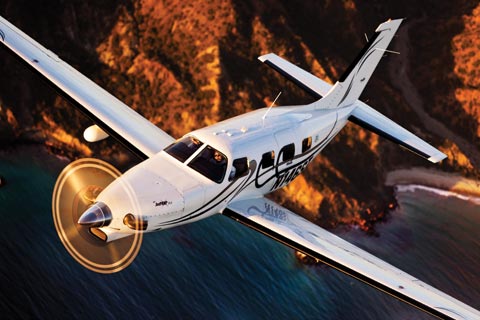
Piper’s PA-46 Malibu/Mirage series of large piston singles burst onto the stage in 1984 and went on to become a major success. These airplanes had the sleek looks that their immediate predecessors, the PA-32 Saratogas, lacked in spades. Their signature design element was their 43-foot, high-aspect-ratio wings, built for maximum efficiency in high-speed cruise. Together with their 310-horsepower Continental TSIO-520 (in the Malibus)—and, since 1989 when a switch was made to the 350-horsepower Lycoming TIO-540 (for the Mirage)—the result was cruise speeds of 200-plus KTAS in the lower flight levels. Some 800 Malibus and Mirages have been sold to date.
Turbine Edition Table of Contents
- Editor in Chief Tom Haines on AOPA Pilot's Turbine editions
- Trials and Travails of the SJ30
- Aircraft Inspections: You Have Choices
- Spoiler Alert
- Logbook Entry: Commentary
But the urge for more speed, better runway performance, and greater engine reliability opened a market niche for Darwin Conrad of JetPROP LLC. Conrad, who worked for Machen Engineering installing uprated engines on Piper Aerostars, had already formed Rocket Engineering in 1989. Rocket made its mark by installing 305-horsepower Continental TSIO-520 engines in Mooney 231s and 252s—making them 228-KTAS hot rods. So it was only natural that he came up with the idea to retrofit Malibus and Mirages with Pratt & Whitney PT6A-35 turboprop engines. Why? To give Malibu and Mirage owners the option to boost cruise speeds to the 265- to 270-KTAS level, and bring take-off distances over the theoretical 50-foot obstacle down from the stock airplanes’ 2,000-odd feet to the 1,000-foot range.
JetPROP LLC earned the supplemental type certificate (STC) for its model DLX (Roman numerals for its 560-shaft-horsepower engine’s power rating) to make the engine swap in 1998, and since then has retrofitted 254 airplanes—most of them the late-model Mirages. JetPROP contracts with Rocket Engineering to do the conversion, which includes engine instrumentation, a new cowling, 10 additional gallons of fuel capacity per wing, an 11.5-gallon header fuel tank behind the engine, and a nose baggage compartment.
The cost of this ambitious STC? $575,000. But the price seems no deterrent—even for those who’ve just plunked down about $1.3 million for a new Mirage. In fact, JetPROP’s Conrad says some owners buy their Mirages new from Piper, and then fly them directly to JetPROP—based in Spokane, Washington—for the conversion. Piper officials point out that this voids the company’s airframe warranty, but Conrad says that the PT6’s bulletproof reliability, 3,600-hour time between overhaul (TBO), and five-year warranty more than compensate. Down time for the conversion is approximately 12 weeks.
A special Pratt
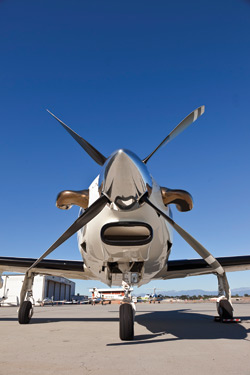 The JetPROP DLX uses a modified version of Pratt & Whitney’s PT6A-135 engine. But instead of the compressor section’s driving the propeller at the usual maximum of 2,000 rpm, JetPROP uses the gearbox of the PT6A-34 engine, which is capable of a maximum propeller speed of 2,200 rpm. The extra 200 rpm is required because the DLX needs a smaller propeller diameter for adequate ground clearance, and props with smaller diameters need to turn faster for good takeoff performance.
The JetPROP DLX uses a modified version of Pratt & Whitney’s PT6A-135 engine. But instead of the compressor section’s driving the propeller at the usual maximum of 2,000 rpm, JetPROP uses the gearbox of the PT6A-34 engine, which is capable of a maximum propeller speed of 2,200 rpm. The extra 200 rpm is required because the DLX needs a smaller propeller diameter for adequate ground clearance, and props with smaller diameters need to turn faster for good takeoff performance.
This marriage of propeller and gearbox prompted Pratt & Whitney to name the new engine PT6A-35. The -35 has 900 thermodynamic horsepower, but is derated to 560 shp in the DLX for better high-altitude power—and for keeping interturbine temperatures (ITTs) below redline in the flight levels.
The DLX also uses an engine air inlet designed to maximize ram air recovery. The inlet lip is one-half to one inch from the rotating propeller disc, which Conrad says makes the engine more efficient at capturing the onrushing ram air than would be the case with a propeller mounted farther forward. “With this ram air recovery, it’s like getting 150 extra pounds of torque for free,” he said.
Rules of thumb
The DLX performs best at FL270—the airplane’s maximum operating altitude—where typical true airspeeds run 265 knots, fuel burns average 33 gph, and maximum IFR range extends to 1,000 nm. Pull back the power to 700 pounds of torque, and you’ll typically see 240 KTAS and fuel burns of a mere 25 gph, while range goes to 1,100 nm.
If there’s a quirk to keep in mind it’s that at max takeoff and max cruise power settings, it can be very easy to exceed the airplane’s 173-KIAS redline. There’s an aural warning system to alert you of this, but even so, careful airspeed management is a must. Here’s another potential gotcha: Maneuvering speed at maximum gross weight is 133 KIAS. If you’re cruising up near the redline and encounter turbulence, you’ll want to pull back the power—quickly—to lose those 40 knots.
DLX versus Meridian
Comparisons between the DLX and Piper’s own purpose-built, single-engine turboprop, the PA-46-500T Meridian, are unavoidable. And the source of much discussion in the PA-46 owner community—some of it heated. JetPROP, of course, points out its airplanes’ higher power rating, shorter takeoff and landing distances, seven-gph lower fuel burn in cruise, and slightly faster cruise speeds.
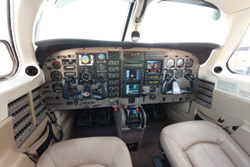 Piper responds that the Meridian has undergone an extensive FAA certification program, while the DLX is a “heavily” STCed airplane. Piper also says that it hasn’t evaluated or tested the DLX. Piper spokesmen say that there are substantial structural differences between the Malibu/Mirage airframe and the Meridian’s—among them a 30 percent larger horizontal stabilizer area—all of which were designed on the basis of flight-test results, and which account for the airplane’s heavier weights. The truth is that the DLX and Meridian have similar specifications—speed, range, and useful loads are similar, for example—but the Meridian’s PT6A-42 engine (derated from 850 to 500 shp) burns slightly more fuel and has 170-gallon fuel tanks, compared to the DLX’s 151-gallon fuel capacity.
Piper responds that the Meridian has undergone an extensive FAA certification program, while the DLX is a “heavily” STCed airplane. Piper also says that it hasn’t evaluated or tested the DLX. Piper spokesmen say that there are substantial structural differences between the Malibu/Mirage airframe and the Meridian’s—among them a 30 percent larger horizontal stabilizer area—all of which were designed on the basis of flight-test results, and which account for the airplane’s heavier weights. The truth is that the DLX and Meridian have similar specifications—speed, range, and useful loads are similar, for example—but the Meridian’s PT6A-42 engine (derated from 850 to 500 shp) burns slightly more fuel and has 170-gallon fuel tanks, compared to the DLX’s 151-gallon fuel capacity.
Wes Oliphant
Wes Oliphant, a developer and property manager in the Palm Springs, California, area, bought a 2004 Piper Mirage in a partnership and had it converted to a JetPROP DLX in 2006. Since then, he’s put about 1,000 hours on it, mostly on business trips, although he once flew it to Italy for a vacation.
Why did he make the conversion? “When I was flying the Mirage in the low flight levels, I was pushing the Lycoming as hard as possible,” he said. “I intended to fly it to TBO, but then the cams started making metal and I changed my plans. It had 400 hours on it when I went to JetPROP.”
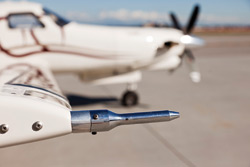 After earning his commercial pilot certificate in 1977, Oliphant bought a Cessna 182, then a Mirage, and then a Beechcraft G36 Bonanza. “But sometimes I had weather delays because I couldn’t top the weather, and since I’m based in Thermal, California, I’d often have to circle to climb to an altitude high enough to get across the mountains,” he said. “Now, climbing to altitude is no problem. Neither is density altitude. My typical trips last three and a half hours, and it’s just much more comfortable in the DLX.”
After earning his commercial pilot certificate in 1977, Oliphant bought a Cessna 182, then a Mirage, and then a Beechcraft G36 Bonanza. “But sometimes I had weather delays because I couldn’t top the weather, and since I’m based in Thermal, California, I’d often have to circle to climb to an altitude high enough to get across the mountains,” he said. “Now, climbing to altitude is no problem. Neither is density altitude. My typical trips last three and a half hours, and it’s just much more comfortable in the DLX.”
Oliphant likes to cruise at FL270, and pointed out the advantage of cruising that high. “There’s a four-knot-per-thousand-foot gain in true airspeed between FL210 and FL270—that’s 24 more knots,” he said.
The day I flew with Oliphant, we were at FL210, doing 170 KIAS and 232 KTAS, burning 34 gph and comfortably below both torque and ITT redlines. “In the Mirage, I’d be doing 200 KTAS and burning 25 gph,” he said. “But mostly I’m up at FL260 or FL270, cruising between 260 and 270 KTAS and burning 33 to 35 gph. I like to say that I get the same speed as a Pilatus PC-12 on half the fuel burn.”
Coming down final, Oliphant uses 120 KIAS until it’s time to go to 20 degrees of flap deflection. Then it’s 350 pounds of torque to slow to full-flap airspeed as the 500-foot callout sounds, go to full flaps, and cross the numbers at 80 KIAS to begin flaring.
Although Oliphant would never go back to a straight Mirage, he still retains a Piper loyalty. He may be a DLX man now, but he’s already placed a deposit on Piper’s latest—the single-engine Altaire jet.
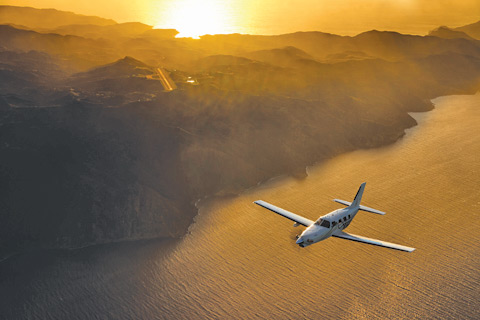
E-mail the author at [email protected].


